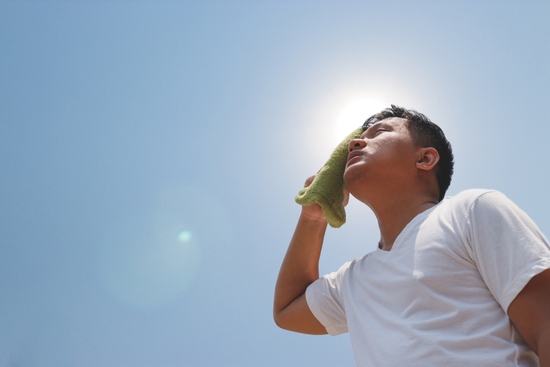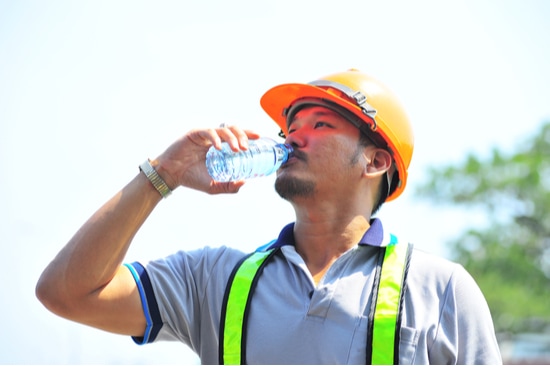The ability to work all day, without the interruptions of rain, snow, or cold weather means summer is peak work time for roofing crews and productivity often gets pushed to the max. However, long, hot summer days can be incredibly dangerous for your field team, increasing their risk of heat illness.
Heat illness can be serious, leading to serious impairments and even death. Learn how to keep your crews safe from heat illness by knowing the signs and symptoms of heat illness, how to treat it once it occurs, and how promote heat illness prevention.
There are many forms of heat-related illnesses, but heat stroke, heat exhaustion, and heat cramps are the most common. Knowing more about these illnesses and recognizing their signs and symptoms can help keep roofing crews safe during the hot summer months.
Read: How Technology is Improving Roofer Safety Conditions
Types of Heat Illnesses & Heat Illness Prevention
Heat Cramps
Heat cramps are often the first sign of heat illness and result from an imbalance of electrolytes in the body due to dehydration. Painful muscle spasming or cramping, usually in the arms, legs, and abdomen, is the most obvious sign of heat cramps along with excessive sweating.
Heat Exhaustion
The next step in heat illness is heat exhaustion. At this point, your body is overheating and lacks the ability to properly cool itself due to a lack of salts and fluids. Someone with heat exhaustion will exhibit excessive sweating, dizziness, fatigue, nausea, and headache. The excessive sweating associated with heat exhaustion is especially problematic because the body is already dehydrated and is unable to replace the fluids lost through sweating, worsening the condition.
Heat Stroke
The most serious form of heat illness is heat stroke, which can arise from untreated heat exhaustion or arise independently.
When heat stroke occurs, the body has over heated to the point where the organs begin to malfunction and shut down. The brain swells, the intestines become more permeable, and your blood vessels dilate, causing blood pressure to drop. On the outside, a person experiencing heat stroke will display a fever, dry and hot skin, nausea and vomiting, dizziness, confusion, agitation, and lethargy.
Extreme cases might even result in seizures or a coma. Note that once a person has reached the heat stroke level, they have stopped sweating excessively and instead show dry hot skin. This is because the body has become dehydrated to the point where they no longer can produce sweat to cool themselves down and it marks a significant progression from heat exhaustion to heat stroke. Now that you are familiar with the signs and symptoms of heat illness, being able to respond to heat illness is the next step in keeping your crew safe.

How to Handle Heat-Related Illnesses
Responding quickly to heat illness is a surefire way to help keep your crews safe. While responding to heat cramps might just mean encouraging your worker to take a quick break, rehydrating, and resting until the cramps subside, responding to heat exhaustion and heat stroke is more serious.
If you think someone on your crew is experiencing heat exhaustion, have them immediately stop working and direct them to a cool shaded place to rest. Provide them with water or a cool sports drink to replenish fluids and electrolytes and use ice packs to cool them down. Roofing crew members experiencing heat exhaustion should go home for the day and not return to work. If symptoms worsen or do not resolve within an hour, the crew member should be taken to receive emergency medical attention.
Heat stroke is the most serious of the heat illnesses so responding to it quickly especially important. Once you see the signs of heat stroke in a crew member, call 911. Getting emergency medical services to your site as soon as possible is critical to keep your crew member safe.
While waiting for emergency medical services to arrive, move the worker to a cool shaded area to sit down and rest. Apply ice packs to help them cool down, focusing on areas such as the armpits and the back of neck. Give them cool water or a sports drink to help replenish fluids and electrolytes. If possible, fan the worker and wet their body with cool water. The goal is to do as much as you can to decrease their body temperature while waiting for emergency medical services to arrive. Be sure to stay with the crew member, continue to cool them, and note any changes in their symptoms until help arrives.
While it is important to recognize the signs of heat illness and know how to respond once you do, taking proper heat illness prevention measures is the most reliable way to help keep your crews safe.

OSHA Recommendations
OSHA recommends a simple approach to heat illness prevention: Water. Rest. Shade. By adhering to these three key steps, keeping your crew safe should be no problem.
The first step: Water. It is recommended that workers drink water every 15 minutes, even if they are not thirsty. Dehydration can sneak up on you, especially in a hot laborious environment, so being proactive is crucial. It is also important to make sure your crew is drinking water, not other beverages such as coffee or soda, which take your body extra energy to process.
The next step is rest. While it can seem like you are wasting valuable work time by taking frequent breaks, the safety of your crew is your priority. In addition to this, is a worker does develop heat illness and has to leave for the day you lose all of their productivity, a much larger hit to your work output than a few breaks.
The last step in preventing heat illness is shade. The sun intensifies heat so do everything you can in the shade. This includes taking rests in the shade and even working in the shade when possible. Note areas that are shady during different parts of the day depending on where the sun is and plan your work to take advantage of those spots when possible. When combined together, Water. Rest. Shade. can be invaluable in helping heat illness prevention in the hot summer months.
Summer is prime time to complete roofing jobs. However, if you are not careful heat illness can become a huge health issue and cost you big in terms of productivity. Thankfully, heat illness is a problem easily managed through preparation, so you can keep your crews safe by taking the proper precautions.
Make sure to educate yourself and your roofers on the signs and symptoms of heat illness, how to respond if they do arise, and the measures to take to prevent them. Doing these things will not only help you keep your crews safe, but also ensure you are getting the most out of your summer work.

